Greetings anatomy students! Flurry over the Outlander premier has abated and S.2 is well underway so it is time for another anatomy lesson. Yay! The bell has rung and class is in session! This anatomy lessons turns our attention to the poorly understood act of emotional crying.
As always, we’ll use Starz images to set the stage for our lesson. Beginning with S.2 opening theme, we are greeted with excellent images of emotional weeping. Claire’s tears flow as she desperately pleads with Jamie after his torture at the hands of the Bloody Blackguard (Starz episode 116, To Ransom a Man’s Soul)!
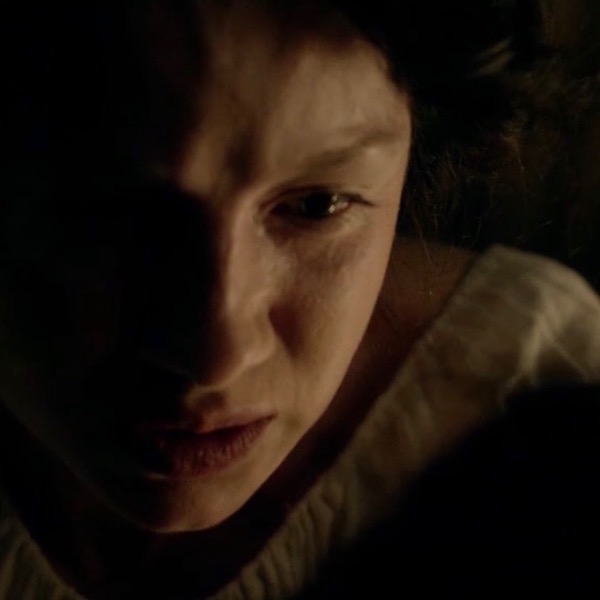
Her tears flow almost unabated through the first half of Starz episode 201, Through a Glass, Darkly. The episode begins with Claire separated from Jamie and her pain is palpable as she shrieks her rage to the heavens (Starz episode 201, Through a Glass, Darkly)!

Her fury is quickly followed with helpless tears of loss and grief as she collapses amid the towering stone monoliths capping Craigh na Dun!
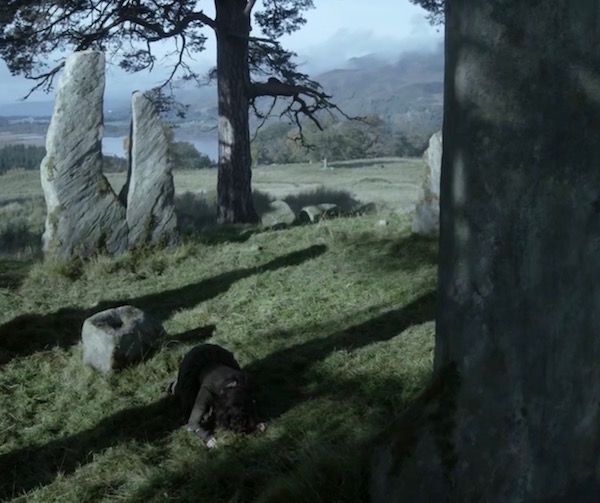
Wandering the road to Inverness, Claire meets a kindly Scotsman. She collapses in desperate sobbing after he reveals, yes indeed, the British won the Battle of Culloden! We empaths shed tears along with our beautiful, courageous heroine!
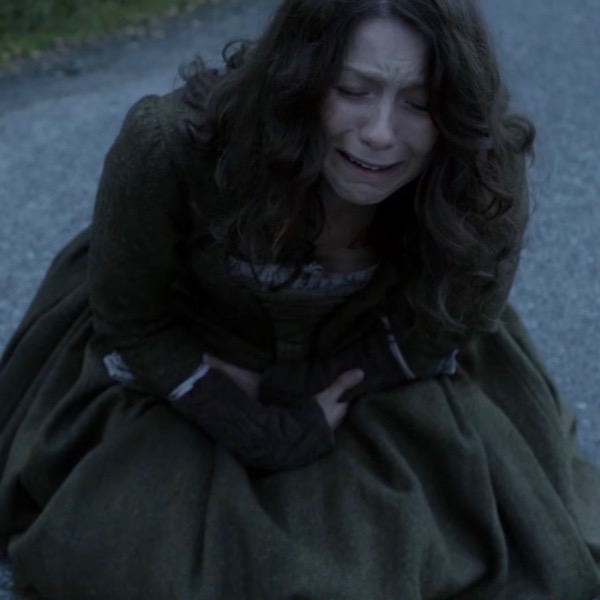
This quote from Diana’s Dragonfly in Amber book adds depth to Claire’s desolation:
I woke three times in the dark predawn. First in sorrow, then in joy, and at the last, in solitude. The tears of a bone-deep loss woke me slowly, bathing my face like the comforting touch of a damp cloth in soothing hands. I turned my face to the wet pillow and sailed a salty river into the caverns of grief remembered, into the subterranean depths of sleep.
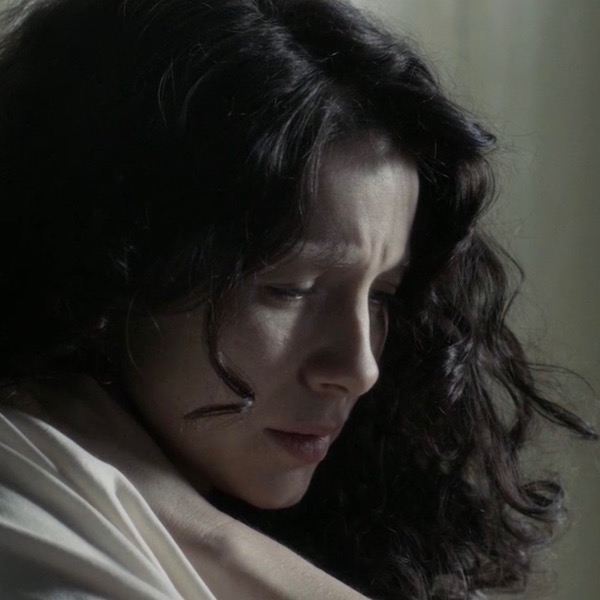
Time to start this tearfilled lesson (sob) with a brief anatomical overview. Unless one suffers from an unfortunate condition such as dry eyes (keratoconjunctivitis sicca), tears flow under three different conditions: base-line tear production, non-emotional tearing, and emotional weeping. Regardless of the cause, all three types involve lacrimation (Latin, lacrima, meaning tear), the production of tears. So, sharpen your scalpels and let’s dissect each type of tear, one-at-a-time.
Base-line Tears: We learned in Anatomy Lesson #30, “Aye, Eye – The Eyes, Part 2,” each eyeball is equipped with a lacrimal apparatus which produces and drains tears. That apparatus includes the following features.
In the upper outer corner of each bony orbit (Anatomy Lesson #30, “Aye, Eye – The Eyes, Part 2,”) lies the small but powerful lacrimal gland (Image A). Most of the gland lies inside the bony orbit but a small part projects into the upper eyelid. Small ducts (channels) pierce the conjunctiva (transparent membrane) and convey the secretion onto the eyeball surface.
The lacrimal gland is designed to continuously secrete (discharge) the aqueous (watery) part of the tear film which bathes the surfaces of cornea and conjunctiva (Anatomy Lesson #30, “Aye, Eye – The Eyes, Part 2,” and Anatomy Lesson #31, “Aye for an Eye – The Eye, Part 3”). Although their roles differ, fibers from both sympathetic and parasympathetic divisions of the autonomic nervous system (the part we don’t control) supply the gland (see Anatomy Lesson #32, “A Real Eye Opener – The Eye, Part 4“). Working together, parasympathetic fibers induce secretion and sympathetic fibers control blood flow.
The tri-laminar tear film (Image A) is composed of an inner mucous (adj.) layer produced by mucous cells of the conjunctiva, a middle aqueous layer produced by the lacrimal gland, and an outer oil layer produced by tarsal glands of the eyelids (Anatomy Lesson #29, “The Eyes Have It! – The Eyes, Part 1”). The tear film represents basal tearing and it is critical to the health of exposed eye surfaces.
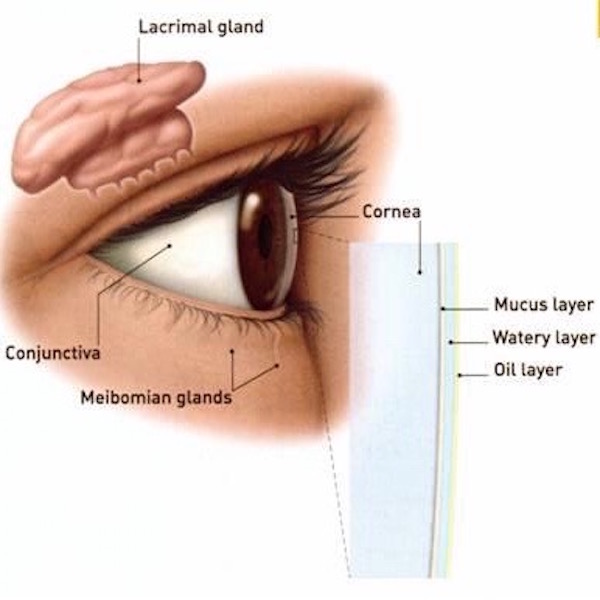
Image A
The tear film is continuously renewed and then drained by the following structures. Closure of the eyelids moves the tear film toward two small openings, the lacrimal puncta (pl.), at the nasal end of each eyelid (Image B – lacrimal apparatus of right eye). Each punctum (find yours) drains into one of two lacrimal canaliculi, tiny channels which empty into a reservoir, the lacrimal sac. From the lacrimal sac, tears traverse the nasolacrimal duct and drain into the ipsilateral (same side) nasal cavity. Remember, each eye has its own lacrimal apparatus.
The tear film doesn’t just give Jamie his sparkling bonny blue orbs; rather, it serves three important purposes:
- Protects and lubricates exposed surfaces of the eyeball.
- Washes away foreign particles.
- Reduces the risk of eye infections (antibacterial).
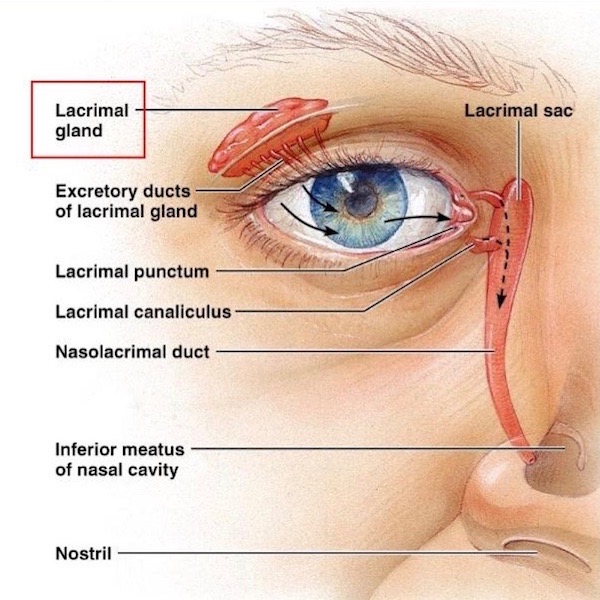
Image B
Non-Emotional Tearing: Also known as reflex tearing, non-emotional tear production is a response to eye irritants. If the exposed eyeball is insulted, the lacrimal glands are stimulated to produce a flood of tears which overwhelms the lacrimal drainage system. Having no adequate outlet, they escape the eyelids and run down the face.
What are the causes of non-emotional tearing? Well, foreign bodies, objects that enter the eye from outside the body, are the most common cause. Although intuitively obvious, here are some important clues that a foreign body may have taken up residence in your eyeball:
- Pressure
- Discomfort or pain
- Sensation of something “in the eye”
- Extreme tearing (yes!)
- Photophobia (pain or discomfort with light exposure)
- Excessive blinking
- Redness or bloodshot conjunctiva (image C)
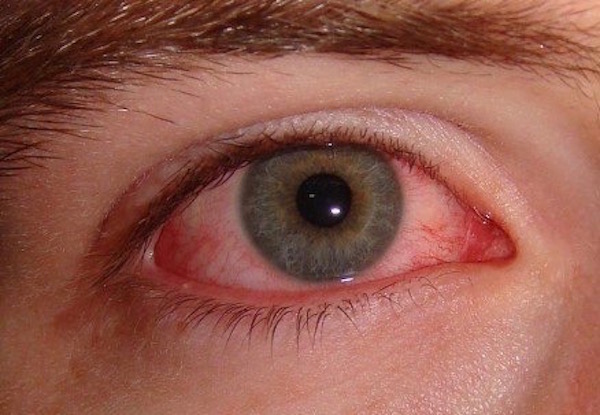
Image C
And just so you know, the following foreign objects are the most common causes of non-emotional tearing:
- eyelashes
- dried mucus
- sawdust
- dirt
- sand
- cosmetics
- contact lenses
- metal particles
- glass shards
Those who read Anatomy Lesson #29, “The Eyes Have It! – The Eyes, Part 1” may recall examples of the now-popular eyelash jewelry, including among other delights, crystals glued to the eyelashes! Who thought that was a good idea? Well, if one is not verra careful, these fake jewels can wreak havoc as foreign bodies! Case in point, crystals float on the tear film overlying conjunctiva and cornea (Image D). These were likely applied to the upper surface of the lower eyelashes. The glue failed and the crystalline escapees drifted onto the eyeball surface.
Understand that if the conjunctiva is intact, objects deposited on the front of the eyeball cannot get lost behind it (Anatomy Lesson #30, “Aye, Eye – The Eyes, Part 2“). They can, however, scratch the cornea and cause infection so foreign bodies in the eye should be resolved STAT!
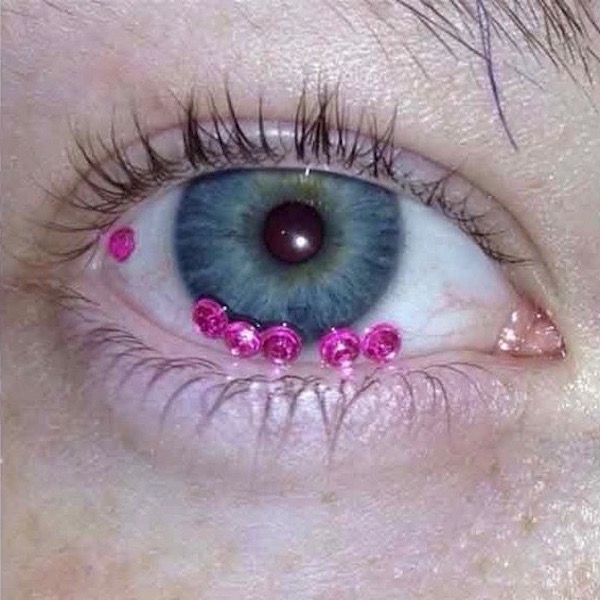
Image D
Then, there are really dangerous foreign bodies such as metal shards (Image E) that pierce the transparent conjunctiva and embed in the sclera (Anatomy Lesson #32, “A Real Eye Opener – The Eye, Part 4“). Such objects can scratch the inner eyelids and cause infections. Och, I bet that hurts!
Protective eyewear can help prevent such injuries and should certainly be worn if working with:
- saws, hammers, grinders, lawn mowers, and other power tools
- dangerous or toxic chemicals
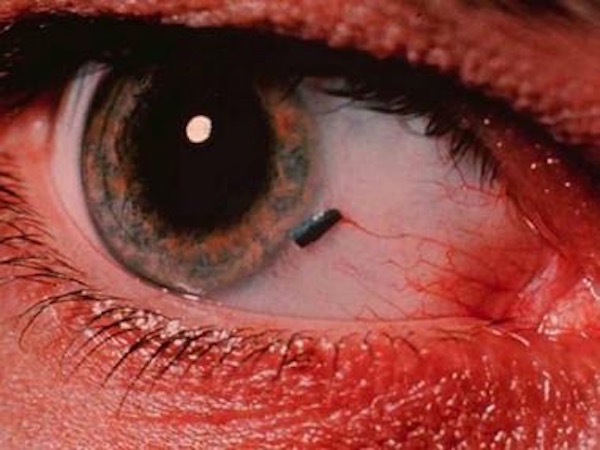
Image E
Non-emotional tearing also follows exposure to irritating substances such as the whiff of onions (Image F) or noxious agents such as insecticides, perfumes, detergents, smoke, dust, etc.

Image F
Well then, fair’s fair (Image G)! Too gruesome? If yes, why are ye watching/reading Outlander? Hee, hee.
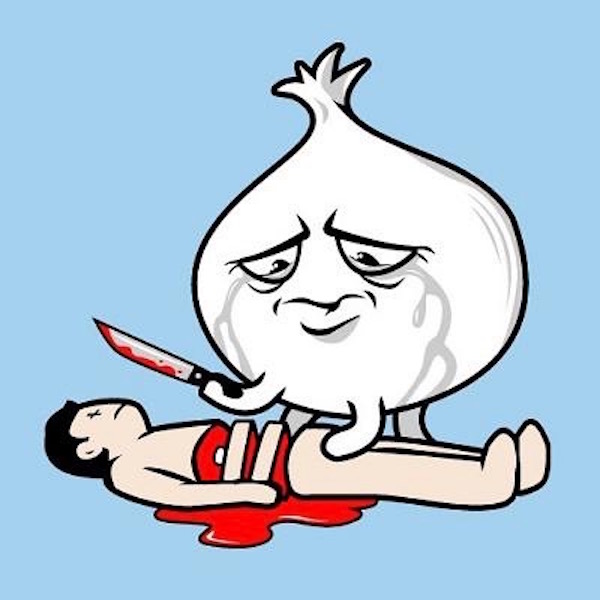
Image G
Speaking of noxious substances, if an across-the-counter product splashes into the eye, you can immediately relieve discomfort and assist tear formation by washing the eyeball. Yes, you read it correctly! Every science laboratory worth its salt sports an eye wash station as part of its safety equipment. Since few homes have such an apparatus, you can use a sink faucet or garden hose. Run a stream of cool water (NOT hot!) from the tap or hose. Open the irritated eye and turn head so the affected eye is DOWN. Let the water run across the eyeball from the nose towards the ear (Image H). Do NOT run water from the ear towards nose! Why? Because the irritant will flow into the lacrimal drainage structures and nose. Voila, now the problem is compounded!
Flush the eye for 15 minutes! Yes your water bill will skyrocket, but the irritant must be thoroughly diluted. Depending on the substance (think acids, lye, etc.), hie to the nearest urgent care facility or call EMT/fire department. In the meantime, wash!
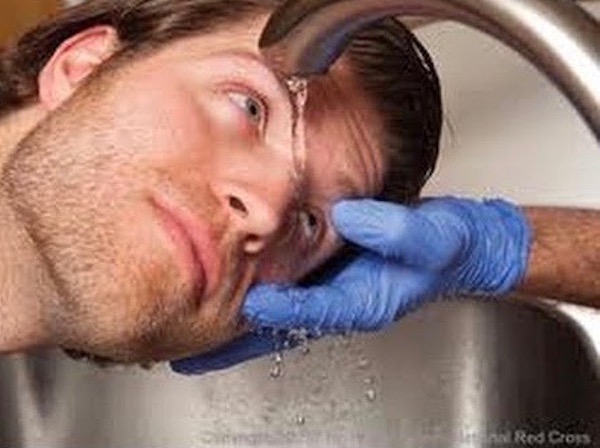
Image H
Finally, if something splashes into both eyes, use a garden hose or a faucet spray nozzle. Look down and widely opening both eyes, allow water to flush them simultaneously. Do not turn the head to either side.
The following is an informative and well-done Youtube video that includes images of how to deal with splashes involving both eyes. Note that although it starts with showing a one eye splash, later it demos both eyes involvement.
Emotional Tearing: Now, we get to the nitty-gritty! Also known as psychic tearing, this is the same as crying, the shedding of tears trigger by emotions. Crying synonyms include weeping, wailing, sobbing, whimpering, squalling, mewling, and bawling. Humans cry if we feel grief, stress, sadness, happy, overwhelmed, pleasure, anger, and suffering. But, the bottom line is, scientists understand very little about why emotions provoke human crying!
Again, Outlander S.2 comes to our rescue: Rage, grief, and despair fuel Claire’s tears in Starz episode 201, Through a Glass, Darkly. But, in the same episode, Frank shares with us fine examples of emotional tears!
Tears of gratitude – Claire has finally returned to him. He doesn’t care who she bedded during her Highland gad-about, nothing could ever change the way he feels about her! No way, Jose!
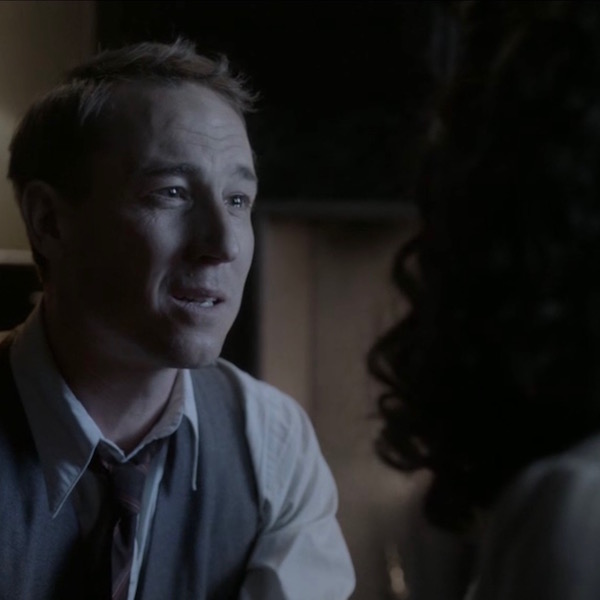
Tears of wonder – After Claire reveals that she has a “bun in the oven”, Jack, oops, I mean Frank, is thrilled and responds with more pop up tears. Oh, my, he is delighted, desperately happy and “over the moon”! Ah, erm…wait! How could such a miracle happen because his doctor told him that …
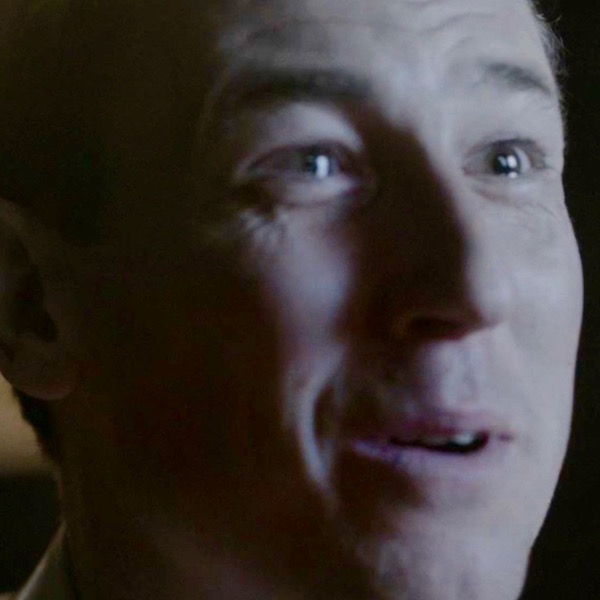
Tears of fury – What? That red-haired bastard (weil, son of a bastard) knocked up his beloved Claire? Who the hey does that guy think he is? And, presto, just like that, Franks’s tears of joy turn into rivulets of rage! So much for his “nothing you could ever do” speech.
Recall not-her-name Sally and her alley cat friends (Starz episode 108, Both sides Now)? Frank came very close to sharing the same black-jack knuckle sandwich with Claire! Fist of fury!
In rapid succession, Frank delivers a wallop of emotion-ladened tears just in time for this lesson. TY, Frank. Much obliged!
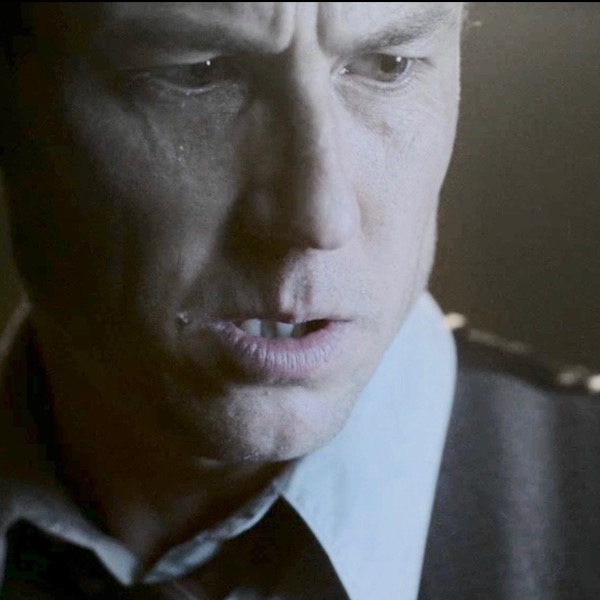
Back to our lesson: many of us ken that newborns wail without tears. Their nascent lacrimal glands produce just enough baseline tears to moisten their eyeballs. Somewhere between 1-3 months the lacrimal glands develop enough to shed tear droplets in response to physical discomfort (Image I).
Around puberty, tears from emotional pain usually overtake those from physical discomfort. Gradually, with age and experience, people add moral crying in response to acts of courage and self-sacrifice or to symbols such as the flag of one’s country or to the sound of bagpipes (my personal favorite)!

Image I
Now, scientists do have insights about how tears and emotions are linked. Emotional crying is a complex secretomotor phenomenon characterized by the shedding of tears sans ocular irritation. The lacrimal gland is linked to the limbic system (Image J), part of the brain that processes emotions. The limbic system (waaaay too complex for this lesson) is hard-wired into the autonomic nervous system/ANS (the part you cannot voluntarily control). With the proper emotional trigger, the limbic system stimulates the ANS to release the neurotransmitter, acetylcholine, a wee molecule which then stimulates the lacrimal gland to shed emotional tears. Ergo, emotions interpreted by the limbic system activate the ANS which releases acetylcholine which turns on the water taps! Voila, we sob with feeling! Pretty remarkable.
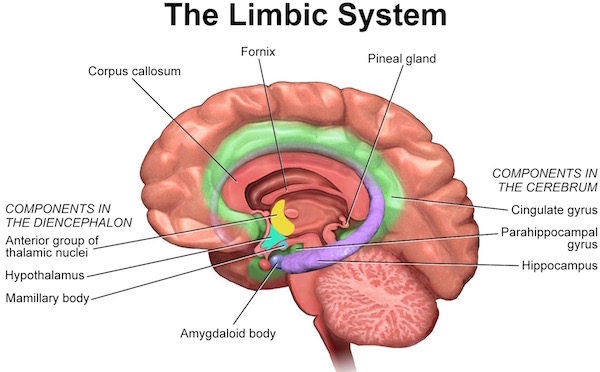
Image J
What we don’t understand is why do strong emotions cause us to cry? What is the purpose of emotional tears? Well, there are lots of ideas, one dating back more than 2,000 years.
Greek philosopher and scientist, Aristotle, posited that tears are waste products like urine and therefore, discarded by the body (Image K): “That they are of one nature is plain to the taste.”
Take comfort, Jamie! Claire isna the only healer to taste urine (deferred to a future lesson). Truth be told, dedicated physicians used to routinely taste their patient’s urine. Talk about the call of duty. Pitooey!
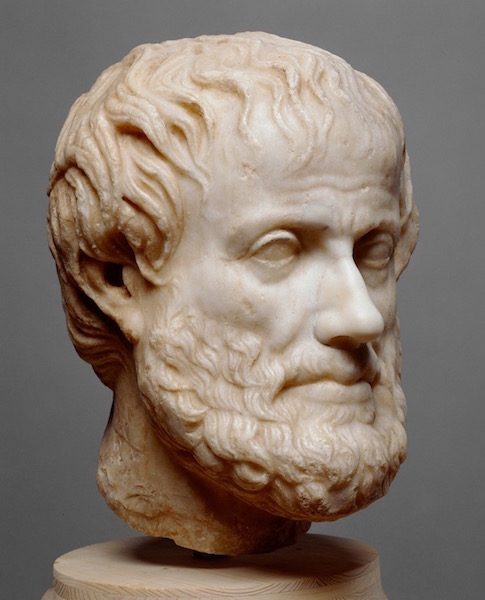
Image K
Here’s a good one…in the 1940s, American psychoanalyst and physician, Phyllis Greenacre, proposed that female weeping is a sign of penis envy and the way a woman can imitate a man urinating. A hypothesis to which I offer this scientific response: Snort!
Others have proposed that tears, like urine production, cleanse the blood. However, the average cry yields only about 20 tear droplets or the equivalent of 1 ml, a totally inadequate amount of fluid loss to alter blood composition.
Some suggest that crying purges the body of harmful chemicals produced under duress. Forty years ago, a biochemist found that emotional tears were richer in protein than non-emotional tears. Unfortunately, others failed to replicate his findings so they lost momentum. A basic tenet of scientific research is that independent laboratories must be able to replicate another’s results…. an excellent check and balance system.
However, later studies have shown that emotional tears contain elevated levels of prolactin (cuddle hormone), adrenocorticotropic hormone (induces adrenal cortex to release the stress hormone, cortisol), and leucine enkephalin (a natural painkiller). So, there may be merit to the idea of emotional purging. Verra complex, are our emotional tears!
Along a similar vein, Darwin proposed that in addition to lubricating the eyeballs, tears “serve as a relief to suffering,” and the idea that crying is cathartic remains viable but unproven. General wisdom suggests that emotional crying does make one feel better. But, why? Well, if misery is short lived, our mood may lighten by the time we finish a good cry. Or, in the midst of despair, something wonderful might happen to completely alter one’s mood such that eyes spout tears of joy!
Intriguingly, some researchers consider emotional crying as a social signal that a person needs nurturing; a sort of primal “shoutout” for help. One interesting study showed pictures of tearful faces to subjects. Within 50 milliseconds (.05 sec.) test subjects reported a boost in feelings of empathy and friendship towards people shown in such images. This very interesting hypothesis awaits further investigation.
Here’s some Outlander proof that social signals work: a mess of fans were ready, willing, and able to comfort that ginger-haired laddie as he wept at Wentworth Prison (Starz episode 115, Wentworth Prison)! Yep!

Here’s another fascinating aspect of emotional tearing. Boys and girls cry with equal frequency until puberty when something complex happens. In Western cultures, boys are conditioned to restrain tears such that women cry twice (one study says 5x) as frequently as men. Biology may also play a role as male puberty is marked by increased testosterone production and some studies hint that this male hormone helps suppress emotional tearing.
Even more interesting, in some social settings such as sports, male displays of feeling such as hugging, cheering, and crying are OK; perhaps because people expect emotions to run high at sporting events. Consider Mario Balotelli, a world class footballer (soccer in US) for team Italy. At the 2012 Euro final, Spain defeated Italy and Mario wept with deep regret (Image L). Apparently, this emotional display did nothing to hinder his career and may have helped it.
Finally, it seems that emotional crying in men can be downright desirable. Studies show that if powerful men display controlled weeping in response to sad or challenging situations, they are perceived as more competent than men who do not. Consider the lion-hearted WW II British PM, Winston Churchill, who has been dubbed the most tearful politician of all time!
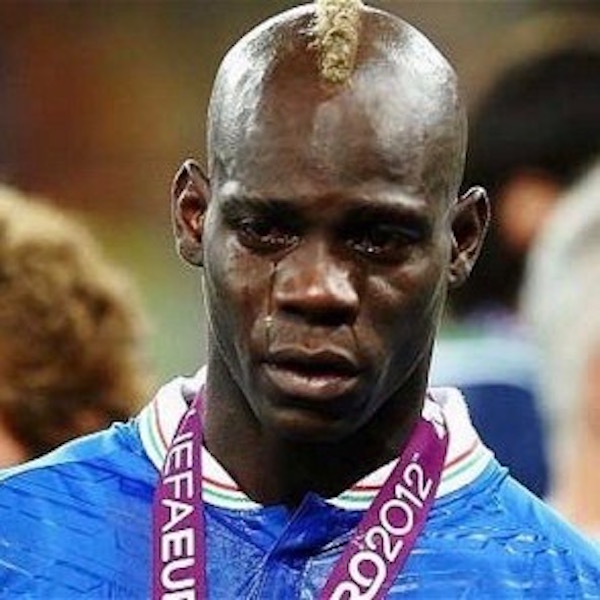
Image L
Another consideration: scientists agree that animals shed tears to protect their eyes but also posit that humans are the only animals that cry based on feeling. Now, I ken that this supposition is bound to rouse some mighty powerful responses from readers who swear their pets display emotions (I’m pretty sure mine do)!
Charles Darwin wrote in The Expression of the Emotions in Man and Animals that keepers of Indian elephants at the London Zoo claim their charges shed tears of sorrow (Image M). And, social media is rife with anecdotal reports that, indeed, animals do demonstrate sadness.
However, science can barely evaluate human emotions much less interpret the emotional status of animals. Understand that this scientific position makes psychic weeping in animals neither true nor false, just not provable at this point in time.
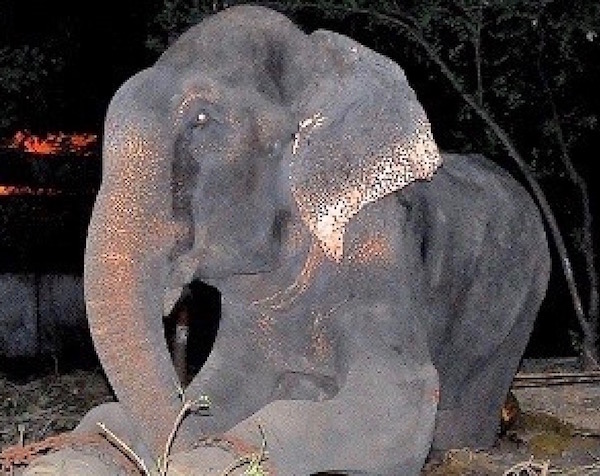
Image M
As if this isn’t enough of teary stuff to contemplate, photographer Maurice Mikkers has recently photographed evaporated human tears and found that no two are alike in salt and mineral deposition (Image N)! ”Every tear is as unique as a snowflake,” writes Maurice. The significance of this fascinating finding awaits further studies.
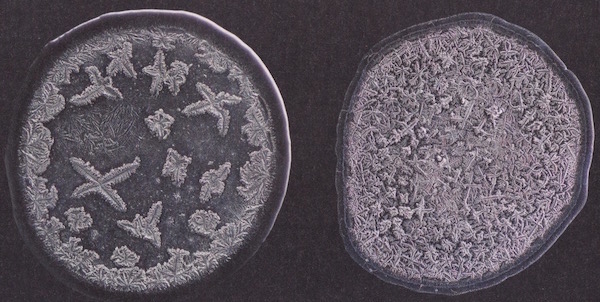
Image N
So, one may safely surmise that the scientific jury is still out on why humans engage in emotional crying. Love it or despise it, crying appears to be a complex, multifactorial response which is crucial to our well-being! Emotional tears are potent symbols of who we are as individuals and as members of the collective whole (such as Outlander fans), celebrating our deepest connections to the world.
Sniff! Now that Outlander has returned to Starz, where is my box of tissues? Awaiting new episodes, but thus far, my favorite emotional tears are those shed by Jamie after Claire declares, “take me home to Lallybroch” (Starz episode 111, The Devil’s Mark). Wake up lad! She’s baaaaack!
Diana’s words from Outlander book!
He slept on his back, as he usually did, hands crossed on his stomach, mouth slightly open. The last rays of daylight from the window behind me limned his face like a metal mask; the silver tracks of dried tears glinted on golden skin, and the copper stubble of his beard gleamed dully…I kissed his cheek, damp and salty.

I close this lesson with an amateur’s haiku poem in honor of Jamie’s emotional weeping:
Ode to Jamie’s Tear
Single tear slips free
Silent, salty and serene…
Pledge of endless love
A deeply grateful,
Outlander Anatomist
Photo creds: Starz, Maurice Mikkers – photographer of human tears (Image N – 27 Feb. 2016, New Scientist), www.dailybhaskar.com (Image D), www.emedicine.medscape.com (Image E), www.en.wikipedia.org (lmage J), www.evolutionaryparenting.com (Image I), www.hubpages.com (Image C), www.huffingtonpost.com (Image M), www.huntingtoneyecare.com (Image A), www.pickchur.com (Image G), www.inthestands.co.uk (Image L), www.studyblue.com (Image B), www.thekoreanforeigner.blogspot.com (Image F), www.vikasacharya.wordpress.com (Image K), www.youtube.com (Image H)

